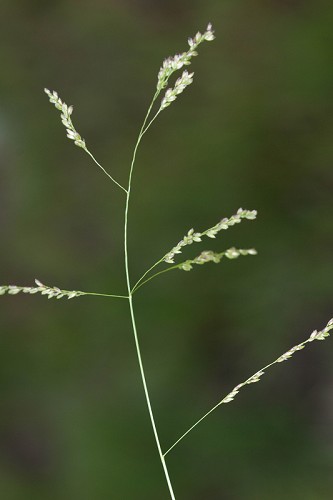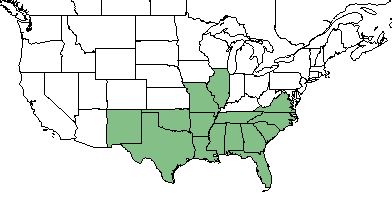Difference between revisions of "Steinchisma hians"
(→Taxonomic Notes) |
HaleighJoM (talk | contribs) (→Ecology) |
||
| (7 intermediate revisions by 3 users not shown) | |||
| Line 30: | Line 30: | ||
==Ecology== | ==Ecology== | ||
===Habitat=== <!--Natural communities, human disturbed habitats, topography, hydrology, soils, light, fire regime requirements for removal of competition, etc.--> | ===Habitat=== <!--Natural communities, human disturbed habitats, topography, hydrology, soils, light, fire regime requirements for removal of competition, etc.--> | ||
| − | This species is found along the shores of streams, ponds, and lakes, as well as in low woods, cypress-gum ponds, floodplains, marshes, ditches, and seepage slopes.<ref name="Weakley 2015"/> ''S. hians'' | + | This species is found along the shores of streams, ponds, and lakes, as well as in low woods, cypress-gum ponds, floodplains, marshes, ditches, pine plantations, and seepage slopes.<ref name="Weakley 2015"/><ref name="FSU"> Florida State University Herbarium Database. URL: http://herbarium.bio.fsu.edu. Last accessed: June 2021. Collectors: Loran C. Anderson, S. T. Cooper, A. H. Curtiss, R.K. Godfrey, and D. L. Martin. States and counties: Florida: Gadsden, Jackson, Jupiter, Leon, and Union.</ref> It is also found in disturbed areas including roadside depressions and railroad embankments.<ref name="FSU"/> |
| + | |||
| + | ''S. hians'' increased its occurrence in response to soil disturbance by roller chopping in south Florida. It has shown regrowth in reestablished habitat that was disturbed by this practice.<ref>Lewis, C.E. (1970). Responses to Chopping and Rock Phosphate on South Florida Ranges. Journal of Range Management 23(4):276-282.</ref> | ||
| + | |||
| + | Associated species include ''Stillin gia, Lachnocaulon, Sarracenia minor, Juncus dichotomous'', and ''Eryngium yuccifolium''.<ref name="FSU"/> | ||
===Phenology=== <!--Timing off flowering, fruiting, seed dispersal, and environmental triggers. Cite PanFlora website if appropriate: http://www.gilnelson.com/PanFlora/ --> | ===Phenology=== <!--Timing off flowering, fruiting, seed dispersal, and environmental triggers. Cite PanFlora website if appropriate: http://www.gilnelson.com/PanFlora/ --> | ||
| Line 36: | Line 40: | ||
<!--===Seed dispersal===--> | <!--===Seed dispersal===--> | ||
<!--===Seed bank and germination===--> | <!--===Seed bank and germination===--> | ||
| − | |||
| − | |||
| − | === | + | ===Fire ecology===<!--Fire tolerance, fire dependence, adaptive fire responses--> |
| + | Populations of ''Steinchisma hians'' have been known to persist through repeated annual burning.<ref>Platt, W.J., R. Carter, G. Nelson, W. Baker, S. Hermann, J. Kane, L. Anderson, M. Smith, K. Robertson. 2021. Unpublished species list of Wade Tract old-growth longleaf pine savanna, Thomasville, Georgia.</ref> | ||
| + | |||
| + | <!--===Pollination===--> | ||
| + | ===Herbivory and toxicology===<!--Common herbivores, granivory, insect hosting, poisonous chemicals, allelopathy, etc--> | ||
This grass is considered one of the top forage grasses in Louisiana woodlands.<ref name="Shiflet 1963">Shiflet TN (1963) A conservation program for grazing woodlands in the southeast. Journal of Range Management 16(1):18-21.</ref> | This grass is considered one of the top forage grasses in Louisiana woodlands.<ref name="Shiflet 1963">Shiflet TN (1963) A conservation program for grazing woodlands in the southeast. Journal of Range Management 16(1):18-21.</ref> | ||
<!--==Diseases and parasites==--> | <!--==Diseases and parasites==--> | ||
| − | ==Conservation and | + | ==Conservation, cultivation, and restoration== |
| + | |||
| + | ==Cultural use== | ||
| − | |||
==Photo Gallery== | ==Photo Gallery== | ||
<gallery widths=180px> | <gallery widths=180px> | ||
</gallery> | </gallery> | ||
==References and notes== | ==References and notes== | ||
Latest revision as of 14:09, 15 July 2022
| Steinchisma hians | |
|---|---|

| |
| Photo by John Gwaltney hosted at Southeastern Flora.com | |
| Scientific classification | |
| Kingdom: | Plantae |
| Division: | Magnoliophyta - Flowering plants |
| Class: | Liliopsida - Moncots |
| Order: | Poales |
| Family: | Poaceae |
| Genus: | Steinchisma |
| Species: | S. hians |
| Binomial name | |
| Steinchisma hians (Elliott) Nash | |

| |
| Natural range of Steinchisma hians from USDA NRCS Plants Database. | |
Common Name(s): gaping panic grass;[1] gaping grass[2]
Contents
Taxonomic Notes
Synonym(s): Panicum hians Elliott.[3]
Description
Steinchisma hians" is a monoecious perennial graminoid.[2]
Distribution
S. hians is found from southeastern Virginia, south to Florida, west to Texas and Oklahoma, and south through Mexico and central America to Colombia. It is also found in southern South America.[1]
Ecology
Habitat
This species is found along the shores of streams, ponds, and lakes, as well as in low woods, cypress-gum ponds, floodplains, marshes, ditches, pine plantations, and seepage slopes.[1][4] It is also found in disturbed areas including roadside depressions and railroad embankments.[4]
S. hians increased its occurrence in response to soil disturbance by roller chopping in south Florida. It has shown regrowth in reestablished habitat that was disturbed by this practice.[5]
Associated species include Stillin gia, Lachnocaulon, Sarracenia minor, Juncus dichotomous, and Eryngium yuccifolium.[4]
Phenology
Flowering occurs from May through October.[1]
Fire ecology
Populations of Steinchisma hians have been known to persist through repeated annual burning.[6]
Herbivory and toxicology
This grass is considered one of the top forage grasses in Louisiana woodlands.[7]
Conservation, cultivation, and restoration
Cultural use
Photo Gallery
References and notes
- ↑ 1.0 1.1 1.2 1.3 Weakley AS (2015) Flora of the Southern and Mid-Atlantic States. Chapel Hill, NC: University of North Carolina Herbarium.
- ↑ 2.0 2.1 USDA NRCS (2016) The PLANTS Database (http://plants.usda.gov, 16 January 2018). National Plant Data Team, Greensboro, NC 27401-4901 USA.
- ↑ Weakley, A.S. 2015. Flora of the southern and mid-atlantic states. Working Draf of 21 May 2015. University of North Carolina at Chapel Hill, Chapel Hill, North Carolina.
- ↑ 4.0 4.1 4.2 Florida State University Herbarium Database. URL: http://herbarium.bio.fsu.edu. Last accessed: June 2021. Collectors: Loran C. Anderson, S. T. Cooper, A. H. Curtiss, R.K. Godfrey, and D. L. Martin. States and counties: Florida: Gadsden, Jackson, Jupiter, Leon, and Union.
- ↑ Lewis, C.E. (1970). Responses to Chopping and Rock Phosphate on South Florida Ranges. Journal of Range Management 23(4):276-282.
- ↑ Platt, W.J., R. Carter, G. Nelson, W. Baker, S. Hermann, J. Kane, L. Anderson, M. Smith, K. Robertson. 2021. Unpublished species list of Wade Tract old-growth longleaf pine savanna, Thomasville, Georgia.
- ↑ Shiflet TN (1963) A conservation program for grazing woodlands in the southeast. Journal of Range Management 16(1):18-21.